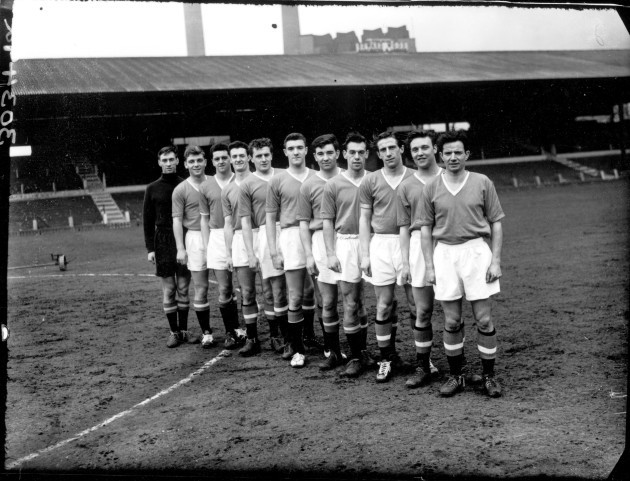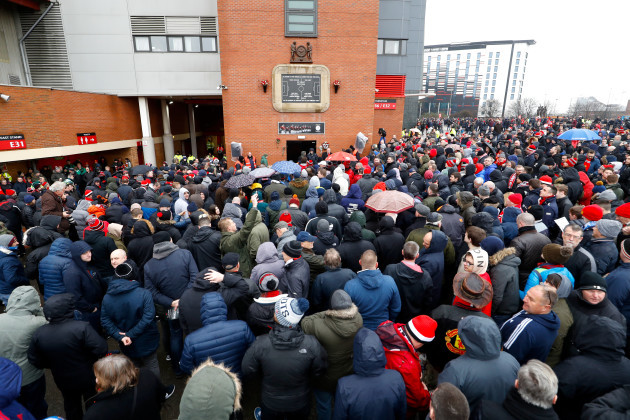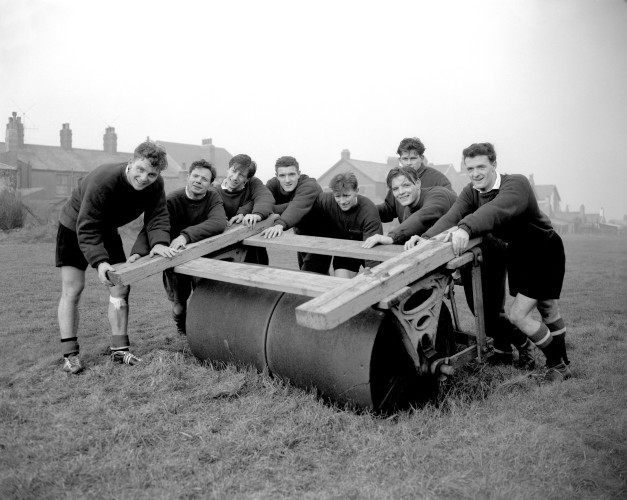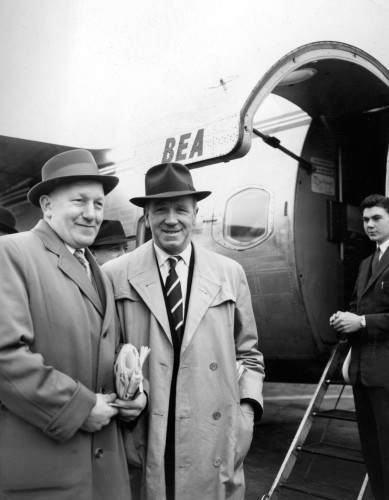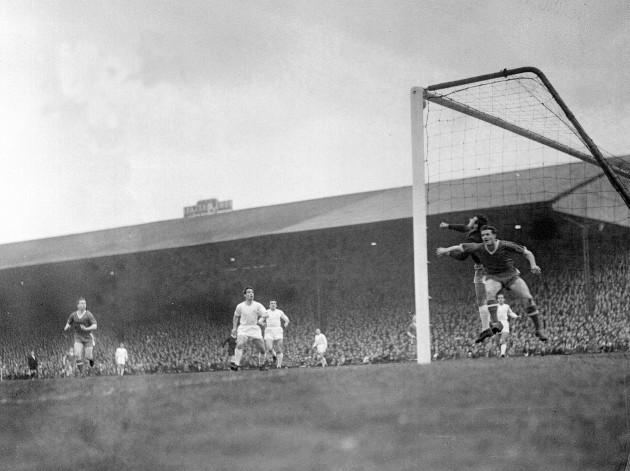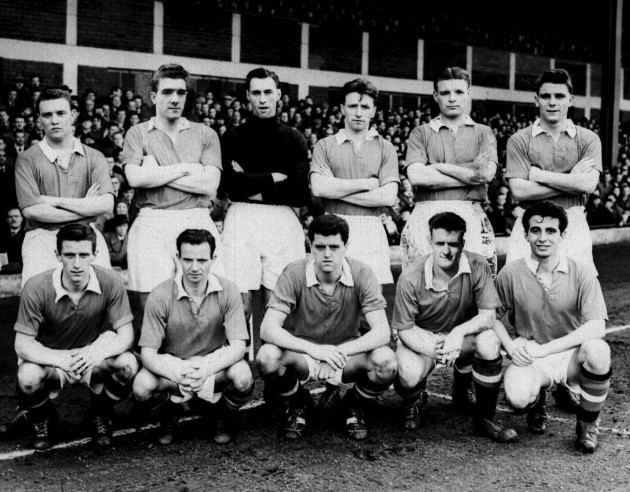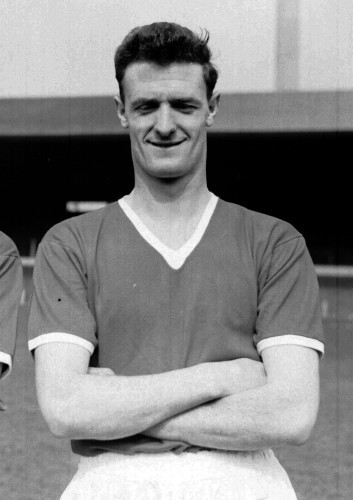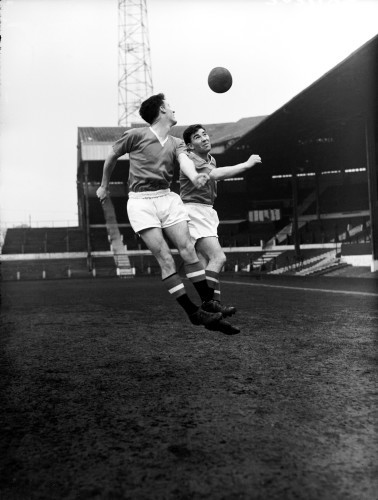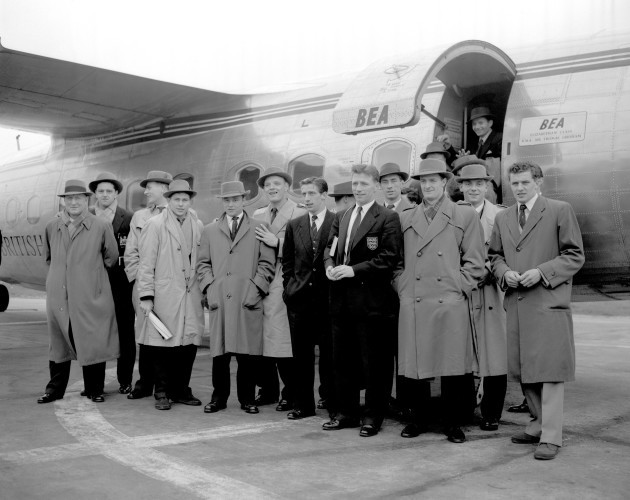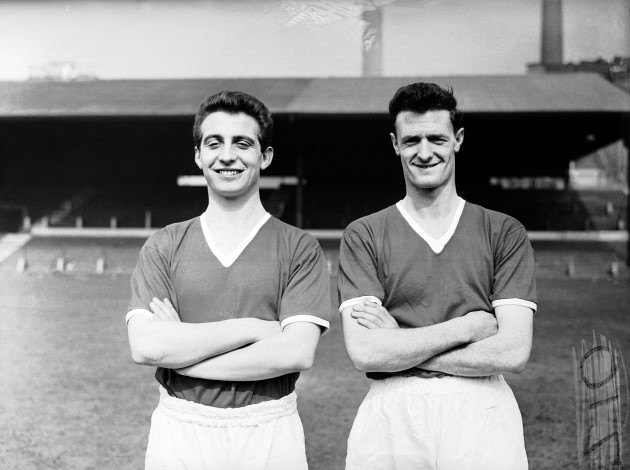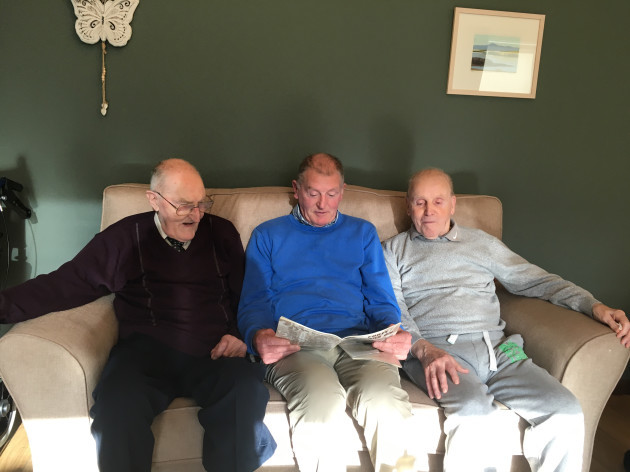DETACHED FROM THE museum and tourist footfall, the St Paul’s section of Glasnevin Cemetery — tucked away to the left of the Finglas Road — can be a lonely place on mornings like this. A glacial wind intermittently swirls from the Phoenix Park direction, briefly subsiding before another harsh gust cuts across moments of peaceful reflection.
There are two other people in sight. An elderly woman, wrapped from the elements in a headscarf, and, further in the distance, a cemetery worker busily clearing leaves.
It’s easy to get lost in your thoughts.
A few plots — nine, to be exact — up on the right hand side from the main entrance, one headstone stands out, not only for its size but for its white granite finish, embellished with a statue of Our Lady of Lourdes on top.
Placed on the grave are red and white flowers with a Manchester United club scarf wrapped around a vase inscribed with the family name. It’s immaculately maintained and beautifully poignant.
In Loving Memory of My Dear Son Liam Whelan,
Of 28, St Attracta Road, Cabra,
Manchester United AFC.
Who died in the Munich Air Disaster,
6th February 1958,
Aged 22 years.
Those words resonate like never before.
Maybe it’s an age thing, maybe it’s just the week that’s in it.
Either way, there is a deep, profound connection.
There is an understanding, and greater appreciation, of what happened, who he was and how the devastating events of 6 February 1958 had such a reverberating effect through so many lives, so close to home.
***
Last Saturday, a large crowd gathered under the Munich Clock, in the south-east corner of Old Trafford, as the 23 victims of the Munich Air Disaster were remembered through prayers, readings and a moving rendition of ‘The Flowers of Manchester’.
The East Stand’s all-glass facade, overlooking the main stadium forecourt, has three large banners running vertically, the centrepiece being a printed replica of the Munich Clock which sits over the statue of Sir Matt Busby. On either side, a list of names.
Geoff Bent
Roger Byrne
Eddie Colman
Duncan Edwards
Mark Jones
David Pegg
Tommy Taylor
Liam ‘Billy’ Whelan.
The Busby Babes.
The English League Champions.
The Flowers of Manchester.
For so many people, for so many reasons, this isn’t an ordinary match day.
The visit of Huddersfield Town to Old Trafford may outwardly be a peripheral fixture in the context of Manchester United’s season, but there is more to this day than football. And particularly this year, the 60th year.
As part of the commemorations, the current Manchester United players wear black armbands and kick off is preceded by a minute’s silence, during which Old Trafford falls deathly silent. It carries significance, and undiluted emotion.
Sitting in the Director’s Box are the families of the victims alongside one of only two remaining survivors, Sir Bobby Charlton, and they will return again later today for a service at Old Trafford, which on days like this truly is a special place, and not just the commercialised version it is often portrayed to be.
Similarly, the same can be said about Manchester United as a club.
74,742 were inside Old Trafford to watch Jose Mourinho’s side win 2-0 and, for the majority, that’s what mattered. It’s what they came to see. But perhaps they left — some heading back to far-flung places — with a better education and understanding of what makes the club they’ve come to worship the way it is.
And why whatever happens on the field, there is a timeless aura of indomitability and a sense of identity forged by the collective suffering through the years. And why there is a Munich Clock and Tunnel forever remembering the men lost on that dark day. And why those who died in Munich became an eternal flame in Manchester United’s history and thus a guiding light for everything the club has gone on to become and achieve.
***
It’s hard to imagine how the crowds managed to all congregate on this side of the cemetery as they did for the funeral. One of the gravediggers told the family he had not seen as many people in Glasnevin since the burial of Michael Collins.
The pictures, although a little grainy, are staggering. You can see rows and rows of people, men and women, young and old, as the heartbreak felt in Manchester extended to an unprecedented outpouring of grief on the streets of Dublin. The city came to a standstill.
The funeral cortege from Dublin Airport to Christ the King Church in Cabra was flanked by thousands upon thousands, as Liam Whelan arrived home on 10 February 1958, four days after he lost his life when British European Airways flight 609 failed to take off on its third attempt at Munich-Riem Airport. He was just 22. He was Dublin’s Busby Babe.
Eight Manchester United players suffered fatal injuries on that inexplicably tragic day, and 15 other passengers — including three members of club staff and eight members of the travelling press — were killed. Matt Busby’s young team were on their way back from a European Cup tie in Belgrade. They were the future of the club, they represented everything about the club. And then Munich. Such shock, such loss.
“Words cannot describe the devastating effect that this disaster had on the football club and the lives of those affected,” Sir Bobby Charlton wrote in a recent letter to Manchester United’s current players. “This great football club, which you are part of, has risen from its darkest hour in a way like no other.”
***
Two hours have passed and we’ve barely scratched the surface. Lost in a myriad of stories, both happy and sad, Christy and John Whelan replay moments in time over in their mind.
They reminisce with pride and great affection and remember how their brother scored twice for Manchester United against Shamrock Rovers at Dalymount Park, how he was man of the match in an FA Cup final in front of 100,000 at Wembley, and how his record of scoring in eight successive top-flight games was only broken by Ruud van Nistelrooy 45 years later.
“They were all happy days,” Christy smiles.
Despite his remarkable goalscoring record — better than one every other game from the inside-forward position — and role in back-to-back league winning sides under Busby, Liam Whelan’s career was only really blossoming when it was so cruelly cut short.
He was the quiet and reserved member of the Busby Babes, but let his performances and goals do the talking, scoring 52 goals in 96 Manchester United appearances.
“He would fetch a fortune today,” says his older brother, who was Liam’s biggest supporter, travelling near and far to watch him playing for Home Farm and then with Manchester United.
Leggy and rake-thin, Whelan was best recognised for his deadly finishing but it was his ball control, vision, mesmerising dribbling ability and capacity to glide past defenders which made him stand out. He could pass, dribble, shoot and finish. He had a wand of a right foot. He had it all.
In a young side nurtured and moulded by Busby and his assistant Jimmy Murphy, containing the likes of Charlton and Duncan Edwards, Whelan was the schemer, the playmaker. He made things tick.
“One of the games we went over to was Blackpool at Old Trafford and the great Stanley Matthews was playing,” Christy recalls. ”We were in the near stand at the time and the ball was over the far side and Matthews had it.
He was rolling the ball and went by somebody, I forget who it was, but who appeared, only Liam. And he took the ball off him and stood in front of Matthews and just kept rolling the ball back and forward down by the corner flag and nutmegged him.
“And the crowd stood up in the stand: ‘Go on, Billy! Show them what ball-playing is all about.’
“I never forgot that.”
***
Later on Tuesday, Home Farm FC will host an event to mark the 60th anniversary of Liam Whelan’s passing, during which a wreath will be laid to commemorate, and celebrate, the life and career of the club’s most famous export. They’re proud of him around these parts, and he was proud to be from Cabra.
His connection with home remained strong during his four years in Manchester, and Whelan, a devout Catholic who suffered from terrible homesickness, would jump on the B&I Ferry back to Dublin as often as he could.
“We used to go down and meet him at the North Wall,” John remembers. “The boat took 14 hours from Liverpool and there were times he used to come home and never say a word and just walk in the door.
“My mother’s favourite saying then was ‘when are you going back?’ because she wanted to know how long he’d be with us.”
Born to Elizabeth and John Whelan of St Attracta Road on 1 April 1935, Liam was one of seven children — Bridie, Alice, Christy, Liam, Rita, Maura and John — but the family tragically lost their father when Liam was just eight, although his love of soccer had already been handed down to eldest son Christy, who had been going to nearby Dalymount Park since the age of five.
Christy himself was a fine player in the League of Ireland, but he soon gave up his own career to follow his younger brother, who was fast becoming the star after first kicking a ball in a playground not far from the family home.
“Liam played in the playground very regularly and there was a team called Red Rockets,” Christy explains. “They used to go around playing in Dublin city and were unbeaten for two years.
“From that, someone suggested he go to join Home Farm and he started playing there at 13. It was a long way away for us at the time with no cars so he used to cycle up to the club. He went from U14 right up, and played a year above himself as well as his own team.
“He got a schoolboy cap for Ireland then and they played England at Goodison Park and won that game 8-4. Liam didn’t score but he was the best player on the pitch that day.”
On the back of that performance, several of the Irish team were invited for trials at Manchester United and a couple of them — Paddy Kennedy and Noel McFarlane — were offered contracts at Old Trafford. But there was no interest in Liam, and despite standing out in Home Farm colours, that continued for another couple of years.
“I didn’t miss one game he played for Home Farm and I used to come home wondering why there wasn’t anybody [scouts] coming to see him play,” Christy says, shaking his head, still to this day bemused by it.
“I used to be saying this to my mother all the time: ‘I don’t know what’s going wrong here, people in this country don’t see it but Liam is the best player I’ve seen in this country.’”
***
There were five tables, each of 10 people, all from completely different backgrounds and walks of life, but all united by Munich. Some knew each other from these events down through the years, others had been passed the baton to carry on the legacy of their loved one.
There were brothers, sisters, sons, daughters, nieces, nephews, cousins, grandchildren, great nieces, great nephews and great-grandchildren, but there was no generation gap. Just an afternoon of mournful reflection and a celebration of everything the Busby Babes stood for through the exchange of stories. It was special.
Hearing how Northern Ireland’s Jackie Blanchflower suffered injuries so severe that he would never play again or how Harry Gregg, who was sitting beside Liam on ill-fated flight 609 but escaped the burning wreckage to save some of his team-mates, including Charlton, could not bring himself to attend this anniversary event because a return to Old Trafford carried too much emotion. He was represented by his son-in-law.
To this day, each family is affected in different ways, but above everything, there is a great sense of pride. There were more smiles and laughs than tears, and words cannot describe the honour felt when Old Trafford rose to show its appreciation for the Munich families as they were welcomed into the Director’s Box.
The affection for the beloved Busby Babes has remained as strong as ever over the last six decades, and on days like this, members of that special team, one which ultimately shaped the future of Manchester United, are in the hearts and minds of supporters, both from Manchester and beyond.
As many as 2,000 supporters have travelled to Munich for a commemoration service while a similar event will take place in Belgrade, where, by pure coincidence, Manchester United’s U19 team are preparing for a Uefa Youth Cup tie. The old Stadion JNA, just like Old Trafford and Home Farm FC, will fall silent at 3.04pm, the exact time a great football team met destruction.
***
1 May, 1953.
“I had been up in Home Farm that evening,” Christy recalls. “They were playing Merrion Rovers and Billy Behan [Manchester United scout] had Bert Whalley [coach] with him and they came over to see Vinny Ryan. He was a great schoolboy at that time as well and went to Glasgow Celtic afterwards, but they had come to sign him for United.
“Liam played well that day. He was brilliant. Just before half-time, Bert Whalley turns to Billy Behan and says ‘I don’t want Ryan, get Whelan and get him as soon as you can.’”
Through the vision of Matt Busby, who held the view that the only way to lay long-lasting foundations for success was through youth, Manchester United placed huge emphasis on developing their own talent, and at the same time created a pattern and philosophy which ran right through from their underage teams to the first team; a free-flowing, thrilling and attractive brand of football which revolutionised the English game.
The Busby Babes offered a template for entertaining football that quickly became the central ideology of Manchester United, and at 18 years of age, a supremely talented young Irish inside-forward fit perfectly into that mould.
“We came home and I was in bed that night, it was fairly late, and half asleep,” Christy continues. “The bedroom door opened and a hand started shaking my shoulder. ’Christy, Christy,’ and I turned and looked, it was Liam. ‘Can you come downstairs?’ he asked.
“I thought there was something wrong. ’There’s some man here from Manchester United,’ he said, to which I replied; ‘It’s about bloody time.’
“We had no dressing gowns so it was an overcoat I put on and went downstairs and Billy Behan was standing there in the living room with Tom Smith from Home Farm.
“Billy just said ‘We want Liam to go over to Manchester United. We want him to play for Manchester United.”
“I remember turning to my mother and she said ‘Christy, they want to take him away’… She didn’t want it. She wanted it for Liam but the thought of one of us leaving the house didn’t sit well with her.
“I said to Billy Behan ‘what is he going over for?’ and he said ‘he’s going over to play in United’s youth team.’ I said ‘is he going over for a trial because he’s too good for a trial.’
“‘No, no trials,’ Behan, said.
“‘Okay, that’s okay with me,’ I said, and that was that. Billy made all the arrangements for a flight over and he went straight away. Off he went at 18.
“I cried that night.”
***
There was a strong Irish connection at Manchester United at the time. Noel McFarlane, Tommy Hamilton, Jackie Mooney, Joe Carolan, Jackie Hennessy and a young Johnny Giles were all also on the books at Old Trafford during the 1950s and became great friends.
Some came and went without ever really making their mark on the first team, but Whelan made an instant impact, starring in the FA Youth Cup final win over Wolves just three days after he signed for the club.
With local lad John Doherty out injured, Whelan was drafted straight into an extraordinarily gifted team containing Kennedy, McFarlane, Eddie Colman, Duncan Edwards, David Pegg and Albert Scanlon, and they won the first leg 7-1 at Old Trafford, with Manchester United’s new recruit scoring the final goal late on before finding the net during a 2-2 second leg draw.
The club would dominate the FA Youth Cup for the first five years of the competition’s existence and Busby’s policy of investing in youth and building teams of world-class footballers was now in full swing.
Not only did the Scot, who had taken his first steps into management with Manchester United in 1945, foster a seismic transition but was bold and brave enough to change the guard and introduce a raft of young rookies into the team.
Whelan had to bide his time before getting his opportunity, but Busby knew of the Irishman’s talent and potential from the outset, particularly after his performances during a youth tournament in Bern, during which watching scouts from Brazilian club Santos made enquiries about his availability.
“He was brilliant and the Brazilians at times stood up and clapped him, they couldn’t believe how good he was,” John remembers. “The skill he had, he had tremendous skill on the ball. He got man of the match and the Brazilians talked to Matt Busby that day.
“But Busby said: ‘He’s going nowhere. If they think they can make him the best player in the world, we can do that.’”
***
Sitting in the shadow of Old Trafford Cricket Ground, 42 Great Stone Road is a small semi-detached, red-brick house on a quiet street in the suburb of Stretford. It’s just a short, straight walk up towards Old Trafford via Sir Matt Busby Way and not far from Manchester city centre.
The greenery is a little overgrown in the front garden and barely recognisable from the last time Christy Whelan was there back in 1954, on one of the many trips over to visit his brother.
“It’s completely different to how I imagined it,” he laughs, looking at a photograph he’s just taken out of his wallet. “There you are now.”
Standing in the driveway are Mrs Whelan, Joe Carolan, Johnny Giles, Christy and the housekeeper Ms Gibbs, who watered and fed Liam and Bobby Charlton during the two years they shared the residence together.
During that time, Whelan was learning his trade for Manchester United’s reserve team in the harsh environments of the Central League but his class shone through, becoming a prolific goalscorer to quickly turn the head of Busby.
“He really started shining then,” says John.
Five days short of his 20th birthday, the young forward was called upon for Manchester United’s First Division game against Preston North End at Deepdale on 26 March 1955.
His first game at senior level ended in a 2-0 victory thanks to goals from Roger Byrne and Scanlon, and the following week Whelan scored the first of his 52 goals in red in a 5-0 demolition of Sheffield United at Old Trafford.
“In his first full season, United won the league by an incredible 11 points but Liam had only played 13 games and you needed to play a third of them to get a medal,” John continues. “But somehow Matt got Liam a medal and then the following year, he was an ever-present in the team.”
The Babes were blossoming and taking English football by storm. Liam Whelan was at the heart of it.
Unbeaten in their first dozen league games in 1956/57, Busby’s side were cutting teams apart at will and while they had a settled core to the team, such was the strength in depth, and calibre of young player at the club, that season also marked the arrival of a certain Bobby Charlton.
Back-to-back league crowns were secured by a margin of 11 points from Tottenham Hotspur and Preston, with United’s high-scoring forwards racking up more than a century of First Division goals during the campaign, with Whelan leading the way on 26.
“33 goals altogether in that season between FA Cup and European Cup,” Christie states. ”He had a tremendous season, and you have to remember Tommy Taylor and Dennis Viollet were spearheading United’s attack that season. It was a staggering achievement.
“That year John went over during Easter for the Burnley game. He wrote to Liam before going over to say he was coming with a group from Home Farm. Anyway, he scored twice that day at Turf Moor and needless to say we were over the moon. Proud as anything.”
***
Off the field, Liam Whelan was a quiet, shy and humble character. He longed for home but at the same time began to settle into life in Manchester — where he was known as Billy — growing up alongside his team-mates in shared digs, creating a formidable and unbreakable team spirit among a young squad.
Both Whelan and the club were reaching rarefied heights, and after their domestic success, soon became European trailblazers despite pressure from the Football Association to decline the opportunity to play on the continent, like Chelsea had done the previous year.
The FA did not want the midweek European travel to affect domestic fixtures but the single-minded and visionary Busby ignored the traditionalists and in realising the boundless benefits of competing against other league winners, refused to bow to higher powers.
In the 1957/58 European Cup, Manchester United were drawn against Shamrock Rovers in the preliminary round, with the first leg of the tie taking place at Dalymount Park. It was the first time a League of Ireland club had qualified for the competition and the game was all the talk around Dublin at the time.
“That was some night,” Christy says, brimming with pride.
Working in the Corporation at the time, one of his colleagues had organised a sweepstake for the first goalscorer and, rather inevitably, Christy drew his brother, who was lining out in the red of United.
“Liam scored twice, but unfortunately it was the wrong two goals he scored,” he laughs.
“The sweep was half a dollar a man, that was two shillings and a sixpence. That was a good bit of money.
“When Liam was leaving the house that evening to go to Dalymount I said ‘hey Mister, I have you in the sweep in work’. ‘Good’, he said and off he went.
“There wasn’t too long gone in the match and the ball came over and unusually for him he missed a wide-open goal. He missed it and cost me the money! But he scored the second and the third goal and United won 6-0. He had a brilliant game.”
With family members dotted around various parts of Dalymount Park, that was a particularly memorable night for the Whelans.
“My mother was in the stand and there were tears,” Christy continues.
The one thing that Liam’s two uncles used to say was ‘if only Johnny was alive’. That was my father. He was fanatical about soccer and I remember Stephen was over in the house after that match.
“I was sitting beside him and he turned to me. ‘You know something, Christy? The saddest part about it all, is that he didn’t live to get to see him, Liam. He would have loved it’ and he was right. It was a great shame.”
***
There isn’t much footage of Liam Whelan in action available, but the clips that are online provide a perfect snapshot of the type of player he was. See his stunning, virtuoso goal in the European Cup quarter-final against Athletic Bilbao as the prime example.
With United trailing 5-2 in the snow and mud, Busby’s side were heading towards elimination when, with five minutes of the first leg remaining, Whelan produced a remarkable moment of individual brilliance to spark an incredible comeback.
Collecting the ball in the middle of the field, he skips past three would-be tacklers before cutting back inside onto his powerful right foot to rifle home into the top-corner from the edge of the area.
“People always remember Liam for his goals, but we remember him for his ability. He was just a brilliant footballer in a brilliant team,” continues John.
United went on to win the second leg 3-0 and advance to the semi-finals, where their first European odyssey ended at the hands of Real Madrid. That was five months before Munich. Disaster lurked around the corner.
***
“It shouldn’t have happened,” Christy says, bowing his head. “It shouldn’t have happened. It wouldn’t happen nowadays.”
The Busby Babes were near-certainties to complete a hat-trick of league titles in the 1957/58 season, and as more talented young players came through the system and the established stars reached their prime, the potential of the team knew no bounds.
There also seemed every chance that an elusive, and much sought-after, League and Cup double — having lost the 1957 FA Cup final to Aston Villa — would become a reality at last and having reached the last four of the European Cup at the first attempt, there was no reason why they couldn’t go two steps further second time around.
After an early slump in form, including three defeats in four games, Busby made a couple of bold changes to his side, as he dropped Ray Wood, Johnny Berry, David Pegg and Whelan, with his close friend Charlton occupying the inside-forward position.
Busby’s decision was instantly vindicated as United’s form and results turned a corner and they embarked on a run of nine games unbeaten but because of the tragic events to come, Whelan’s last game for the club was in a 1-0 defeat to Chelsea in December 1957.
Having been beset by a bout of the flu, while also hearing news from back home of his mother’s bad health, he remained out of the team at the expense of Charlton by the time United reached the quarter-finals of the European Cup.
After safely advancing past Shamrock Rovers in that famous tie, they made light work of Dukla Prague to set-up a last eight date with Red Star Belgrade in January 1958.
Busby’s side were far from their clinical best in the first leg but managed to emerge with a 2-1 victory before travelling to Belgrade for the second leg on 5 February 1958. They drew 3-3 but advanced to a second successive European semi-final 5-4 on aggregate.
The great tragedy is that Whelan had sought permission from Busby to return home to Dublin for a few days, but the United manager wanted the whole squad to travel to Serbia in a show of unity.
“It was only a matter of time before Liam got back in the team but he wanted to come home,” John explains. “You could see where Matt was coming from because if anyone got injured, there was no sense in Liam being in Dublin.
“But he wanted to come home to make arrangements for his wedding. That’s what I thought anyway. He was engaged to Ruby and they were due to get married the following summer but that was it, he went on the trip. God knows his own ways.”
***
“The tragic news of Liam Whelan’s death reached his family home at St Attracta Road, Cabra, late last night, after hours of agonised waiting. From the time the first reports of the disaster reached Dublin, crowds gathered at the Whelan home and phone calls for news of Liam were put through to Manchester at regular intervals on a phone in a neighbour’s house. Schoolboy friends waited silently, hoping against hope for the word that he survived.”– The Irish Press, 7 February 1958.
After celebrating their victory at the post-match banquet the night before, Manchester United’s players boarded the twin-engined British European Airways plane, flight 609, for their journey back to Manchester via Munich to refuel.
Upon arrival at a snow-covered and sub-zero Munich-Riem Airport, the squad got off the plane to spend some time in the terminal building before embarking on the second leg of their trip home. Shortly after 2pm local time, the 44 passengers were back on the aircraft and the first of three aborted take-off attempts was made.
As the pilot attempted to get the aircraft, known as the Lord Burleigh, off the ground, the engine made a strange noise and captain James Thain and his co-pilot Kenneth Rayment slammed on the brakes, stopping just 400 yards from the end of the runway.
A couple of minutes later, a second attempt was abandoned in near identical circumstances, before the aircraft was taxied back to the terminal to be examined by engineers on the ground. At that stage, everyone on board returned to the relative warmth of the lounge.
By 3.02pm, a decision had been made. The pilot informed the control tower that they would try again, for a third time. The engineers were satisfied that the noise didn’t pose a safety threat and Thain was content that the wings hadn’t iced over.
Passengers who survived have since described the mood as apprehensive, but there wasn’t a great deal of panic, although the previous boisterous mood as the players played cards had silenced considerably. Some, including Duncan Edwards, Tommy Taylor and Mark Jones, had decided to move to the back of the aircraft in the hope it was safer.
“It was an awful decision,” John says. “There were actually photographs of some of the players sweeping snow off the wings. There were under pressure to get home. They had a league fixture to fulfil on the Saturday.”
The aircraft failed to gather enough speed on the icy surface, overshooting the runway and smashing through the perimeter fence and into a nearby house. As the plane hurtled along the slushy runway and towards destruction, Liam uttered the chilling words: “If this is the end, then I am ready for it.”
The cockpit hit a tree and part of the fuselage slammed into an airport fuel hut, which instantly exploded. The wing and part of the back were torn off. Some were killed instantly, others lay among the debris unconscious and beyond help. Utter destruction and devastation.
Back home in Dublin, the Whelan family learned of the shattering news hours after it had first broken.
“I was sitting in a chair like this in front of the fire at the time and the next thing I heard the gate,” Christy recalls.
“My mother and Alice were out the back ironing and I saw it was Charlie Jackson, who used to look after Liam’s team in Home Farm. He was a good friend of the family.
“I shouted out ‘here’s Charlie’ and my mother came into the front room and pointed at the clock and said ‘they’re home Charlie, they’re home.’
“‘I’m afraid not, Mrs Whelan,’ he said.
“‘What’s wrong, Charlie? They’re home, Charlie.’
“Have you not heard,” he said. “I’ve come up to offer my condolences and to be with you when we’re waiting. The plane has crashed.”
“The whole of Dublin knew and we didn’t,” Christy continues, looking to the sky. “We were all in here and we hadn’t heard.”
As news filtered through and the whole picture emerged, the scale of the tragedy became agonisingly clear.
“We would get the bulletins and they were going through all the names: Geoff Bent — dead. Eddie Colman — dead. Tommy Taylor — dead. But there was no mention of Liam. The house was full of people but we all knew.
“We eventually got a phone call and I went in and it was Jimmy Murphy…
“‘Christy, we’ve bad news,’ he said. ‘Liam didn’t survive. From what’s left here at Old Trafford, we send our sympathies. We’ll be in touch and will help you through this.’
“My mother insisted on leaving the radio on in case news came through that he had survived. She didn’t want to believe it. She took it badly and late that night, she came into me and said: ‘Christy, if he was dead, wouldn’t the police have come to us?’
He pauses, before adding: “And I had to tell her…I had to tell her that the police had come and given official notice of Liam’s death.”
***
Liam Whelan’s prodigious talent may have been extinguished, but his legacy and legend has grown over the years since his death. His record for Manchester United speaks for itself and it’s widely acknowledged that he was not just cut down in his prime, but before he had even reached it.
Described as the lost talent of Irish football, Whelan was nudging greatness when tragedy intruded, and it was perhaps his unassuming disposition, and reluctance to appear in the media, that cost him the affection in which some of his team-mates were held.
But from anyone who knew him, played with him or watched him play, there was nothing but adulation and admiration for one of the finest players of his generation who would have undoubtedly gone on to even greater things.
He earned four international caps for the Boys in Green during Ireland’s qualifying campaign for the 1958 World Cup, but was cruelly denied the opportunity to truly fulfil his potential both for club and country.
Under the tutelage of Busby and Murphy, and playing alongside such gifted players at Old Trafford, the horizon for Whelan appeared boundless. Without question, he was one of the greatest footballers Ireland has ever produced.
Even more heartbreaking was the fact he was due to be joined in Manchester by his soon-to-be wife Ruby and the pair planned on settling down together in England, which would certainly have eased his homesickness and helped his performances on the pitch. Alas, it wasn’t to be.
“He had a great career for the time he was there but if he hadn’t have been homesick he would have been even better,” Christy laments.
Whelan’s death left a hole as big as any at Old Trafford, where he was revered but it was back home in Cabra where he was beloved both personally and professionally by those who both knew him, grew up with him and followed him.
“Liam loved to stay involved with the community,” Christy continues. “There was a five-a-side tournament in Dalymount Park and Liam brought a team over from England. He was home in the house anyway and a few kids, maybe six to eight year olds, knocked on the door and asked ‘is Liam coming out?’
“He had just played in the FA Cup final at Wembley but Liam wouldn’t say no to anybody. He gave them money to go to the shop up by the bridge [now named after him] to buy a ball and when they got back, he was out playing on the road with them.
“He was so popular. He never gave anyone any reason to say ‘that fella is a bloody snob’. When he was home, he’d stop and chat to everyone. He was so loved and we saw that at the funeral. It was a sad occasion.”
In just four years at Manchester United, he left a lasting legacy and achieved immortality through his gifted performances in red and the part he had to play in the evolution and success of the Busby Babes.
His team-mates were all universal in praise. “As a youngster, I always wanted to be the best player in the world but as long as Liam Whelan was around I doubted if I could,” Bobby Charlton wrote in his book, providing another indication of just how highly he was rated.
“God knows how good he would have been,” John remarks, desperate to know the answer. But at the end of the day, football and goals and caps is all a trivial matter in the greater context of the tragedy to befall Matt Busby’s thrilling, pioneering young team.
Lives, futures and families were shattered on that indelible day, today 60 years ago.
“It’s hard to believe it’s that long ago,” Christy adds. “But one thing is for sure: Liam is never forgotten. He’s never forgotten and never will be.
My mother had a very good way of looking at it and she always said ‘God wanted Liam’ and that helped us a lot. It got us through those days and weeks and months and years. It gets us through even now all these years after. God wanted Liam and that’s how we saw it.
“We are all so proud of him and the memories have always been there. He was so skilful and they [the press] used to say he was slow, but he could get there! He could take them all on and beat them. He was terrific, he was a terrific boy.
“Liam will never be forgotten and even long after we’re gone, his memory will be kept going by the rest of the family.”
The 42 is on Instagram! Tap the button below on your phone to follow us!
